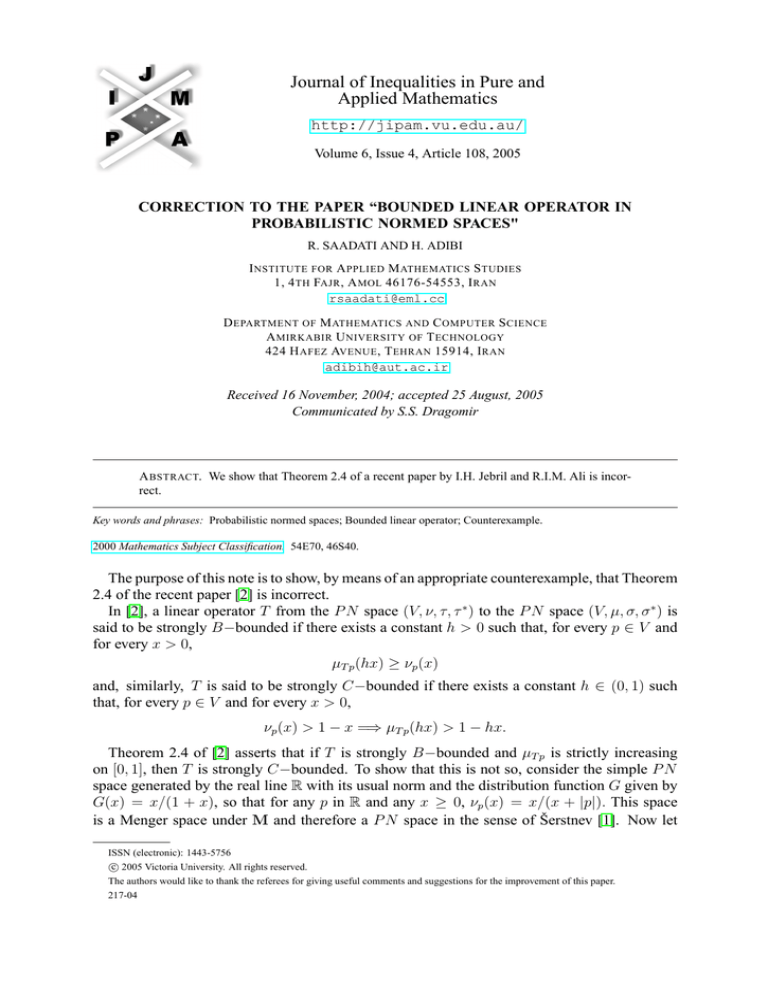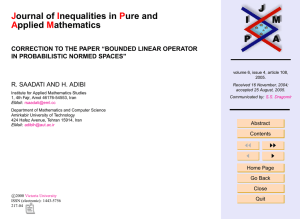
Journal of Inequalities in Pure and
Applied Mathematics
http://jipam.vu.edu.au/
Volume 6, Issue 4, Article 108, 2005
CORRECTION TO THE PAPER “BOUNDED LINEAR OPERATOR IN
PROBABILISTIC NORMED SPACES"
R. SAADATI AND H. ADIBI
I NSTITUTE FOR A PPLIED M ATHEMATICS S TUDIES
1, 4 TH FAJR , A MOL 46176-54553, I RAN
rsaadati@eml.cc
D EPARTMENT OF M ATHEMATICS AND C OMPUTER S CIENCE
A MIRKABIR U NIVERSITY OF T ECHNOLOGY
424 H AFEZ AVENUE , T EHRAN 15914, I RAN
adibih@aut.ac.ir
Received 16 November, 2004; accepted 25 August, 2005
Communicated by S.S. Dragomir
A BSTRACT. We show that Theorem 2.4 of a recent paper by I.H. Jebril and R.I.M. Ali is incorrect.
Key words and phrases: Probabilistic normed spaces; Bounded linear operator; Counterexample.
2000 Mathematics Subject Classification. 54E70, 46S40.
The purpose of this note is to show, by means of an appropriate counterexample, that Theorem
2.4 of the recent paper [2] is incorrect.
In [2], a linear operator T from the P N space (V, ν, τ, τ ∗ ) to the P N space (V, µ, σ, σ ∗ ) is
said to be strongly B−bounded if there exists a constant h > 0 such that, for every p ∈ V and
for every x > 0,
µT p (hx) ≥ νp (x)
and, similarly, T is said to be strongly C−bounded if there exists a constant h ∈ (0, 1) such
that, for every p ∈ V and for every x > 0,
νp (x) > 1 − x =⇒ µT p (hx) > 1 − hx.
Theorem 2.4 of [2] asserts that if T is strongly B−bounded and µT p is strictly increasing
on [0, 1], then T is strongly C−bounded. To show that this is not so, consider the simple P N
space generated by the real line R with its usual norm and the distribution function G given by
G(x) = x/(1 + x), so that for any p in R and any x ≥ 0, νp (x) = x/(x + |p|). This space
is a Menger space under M and therefore a P N space in the sense of Šerstnev [1]. Now let
ISSN (electronic): 1443-5756
c 2005 Victoria University. All rights reserved.
The authors would like to thank the referees for giving useful comments and suggestions for the improvement of this paper.
217-04
2
R. S AADATI AND H. A DIBI
T : R → R be the linear map defined by T p = 2p and note that ν2p is strictly increasing on
[0, 1]. Then if h > 2,
hx
hx
νT p (hx) =
≥
= νp (x),
hx + 2|p|
hx + h|p|
whence T is strongly B−bounded. (Note that this holds in any simple P N space.) But for
x = 1/2 and p = 1/4, we have νp (x) = 2/3 > 1/2 = 1 − x, whereas, for any h in (0, 1),
ν2p (hx) = h/(1 + h) < 1 − h/2 = 1 − hx, so that T is not strongly C−bounded.
R EFERENCES
[1] C. ALSINA, B. SCHWEIZER AND A. SKLAR, On the definition of a probabilistic normed space,
Aequationes Math., 46 (1993) 91–98.
[2] I.H. JEBRIL AND R.M. ALI, Bounded linear operator in probabilistic normed spaces, J. Inequal.
Pure Appl. Math., 4(1) (2003), Art. 8. [ONLINE: http://jipam.vu.edu.au/article.
php?sid=244]
J. Inequal. Pure and Appl. Math., 6(4) Art. 108, 2005
http://jipam.vu.edu.au/








